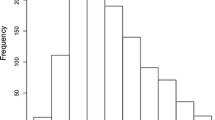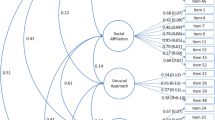Abstract
The validity of a social subtyping scheme forwarded by Wing and her colleagues is examined in a sample of 53 autistic individuals. Clinical ratings of subtype (aloof, passive, active-but-odd), IQ estimates, and measures of adaptive functioning and level of autism were obtained. Subjects were individually administered the Autism Diagnostic Observation Schedule (ADOS) by the principle examiner, who was blind to subtype assignment. The general findings supported the validity of aloof and active-but-odd subtypes as predictors of behavior across language/communication, reciprocal social interaction, and stereotyped behavior/restricted interest domains and suggested that individuals assigned to these respective groups differed in a number of important ways (e.g., level of autism, IQ, adaptive behavior). Partial support for an intermediate, passive subtype was garnered. The clinical utility of social subtypes is discussed as an important implication of this work.
Similar content being viewed by others
References
American Psychiatric Association. (1980).Diagnostic and statistical manual of mental disorders (3rd. ed.). Washington, DC: Author.
American Psychiatric Association. (1987).Diagnostic and statistical manual of mental disorders (3rd. ed., rev.). Washington, DC: Author.
Borden, M. C., & Ollendick, T. H. (1992). The development and differentiation of social subtypes in autism. In B. B. Lahey & A. E. Kazdin (Eds.),Advances in clinical child psychology (Vol. 14). New York: Plenum Press.
Cicchetti, D. V., & Sparrow, S. A. (1981). Developing criteria for establishing interrater reliability of specific items: Applications to assessment of adaptive behavior.American Journal of Mental Deficiency, 86, 127–137.
Fleiss, J. K. (1981).Statistical methods for rates and proportions (2nd ed.). New York: Wiley.
Hinkle, D. E., Wiersma, W., & Jurs, S. G. (1988).Applied statistics for the behavioral sciences. Boston: Houghton Mifflin.
Kanner, L. (1943). Autistic disturbances of affective contact.Nervous Child, 2, 217–250.
Leach, C. (1979).Introduction to statistics: A non-parametric approach for the social sciences. New York: Wiley.
Le Couteur, A., Rutter, M., Lord, C., Rios, P., Robertson, S., Holdgrafer, M., & McLennan, J. (1989). Autism diagnostic interview: A standardized investigator-based instrument.Journal of Autism and Developmental Disorders, 19, 363–387.
Lord, C., Rutter, M., Goode, S., Heemsbergen, J., Jordan, H., Mawhood, L., & Schopler, E. (1989). Autism diagnostic observation schedule: A standardized observation of communicative and social behavior.Journal of Autism and Developmental Disorders, 19, 185–212.
Prizant, B. M., & Schuler, A. L. (1987). Facilitating communication: Language approaches. In D. J. Cohen & A. Donnellan (Eds.),Handbook of autism and pervasive developmental disorders. New York: Wiley.
Rutter, M., & Garmezy, N. (1983). Developmental psychopathology. In M. E. Hetherington (Ed.),Handbook of child psychology (Vol. 4). New York: Wiley.
Rutter, M., & Schopler, E. (1988). Autism and pervasive developmental disorders. In M. Rutter, A. H. Tuma, & I. S. Lann (Eds.),Assessment and diagnosis in child psychopathology. New York: Guilford.
Schopler, E., Reichler, R. J., & Renner, B. R. (1986).The childhood autism rating scale (CARS) for diagnostic screening and classification of autism. New York: Irvington.
Siegel, B., Anders, T. F., Ciaranello, R. D., Bienenstock, B., & Kraemer, H. C. (1986). Empirically derived subclassification of the autistic syndrome.Journal of Autism and Developmental Disorders, 16, 275–293.
Sparrow, S., Balla, D., & Cicchetti, D. (1984).Vineland Adaptive Behavior Scales (Survey Form). Circle Pines, MN: American Guidance Service.
Volkmar, F. R., Cohen, D. J., Bregman, J. D., Hooks, M. Y., & Stevenson, J. M. (1989). An examination of social typologies in autism.Journal of the American Academy of Child and Adolescent Psychiatry, 28, 82–86.
Weist, M. D., Ollendick, T. H., & Finney, J. W. (1991). Toward the empirical validation of treatment targets in children.Clinical Psychology Review, 11, 515–538.
Wing, L. (1981). Language, social, and cognitive impairments in autism and severe mental retardation.Journal of Autism and Developmental Disorders, 11, 31–44.
Wing, L., & Attwood, A. (1987). Syndromes of autism and atypical development. In D. J. Cohen & A. M. Donnellan (Eds.),Handbook of autism and pervasive developmental disorders. New York: Wiley.
Wing, L., & Gould, J. (1979). Severe impairments of social interaction and associated abnormalities in children: Epidemiology and classification.Journal of Autism and Developmental Disorders, 9, 11–30.
Author information
Authors and Affiliations
Additional information
The authors thank the staff and students of Grafton School, Berryville, Virginia, and The May Institute, Chatham, Massachusetts, for their assistance in completing this project. Thanks also to Amy Clark and Thea De Young for serving as reliability raters and to Anne S. Walters for her comments on an earlier draft of the manuscript.
Rights and permissions
About this article
Cite this article
Borden, M.C., Ollendick, T.H. An examination of the validity of social subtypes in Autism. J Autism Dev Disord 24, 23–37 (1994). https://doi.org/10.1007/BF02172210
Issue Date:
DOI: https://doi.org/10.1007/BF02172210




